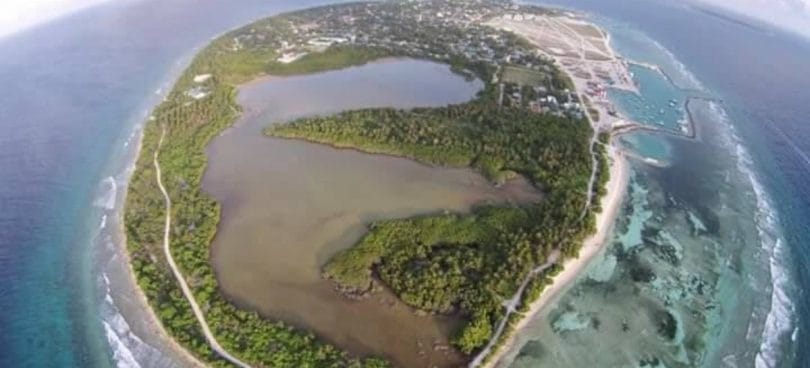The Environmental Impact Assessment report for developing an airport on Kulhudhufushi after reclaiming the northern island’s mangrove has yet to be submitted, sources from the Environment Protection Agency has confirmed.
The government’s plans to begin dredging the environmentally sensitive wetland area sparked an outcry from islanders and environmentalists.
Ibrahim Naeem, the EPA’s director general, hung up the phone when the Maldives Independent asked about the EIA report on Monday. The consultant who conducted the assessment earlier this year also declined to comment.
The law requires a one-month period to seek public opinion after the EIA report is submitted for approval by the EPA.
But Ibrahim Ziyath, CEO of the state-owned Maldives Transport and Contract Company, told the press on Sunday that the company’s new dredger Mahaa Jaharaff will dock at the Kulhudhufushi harbour this week.
President Abdulla Yameen will inaugurate the reclamation project during November, after which some 6.21 hectares will be reclaimed in 180 days, he said.
Developing an airport on Kulhudhufushi, the main population hub in the northern atolls, was a campaign pledge Yameen made in August 2013, despite an international airport located on the nearby island of Hanimadhoo, a 25-minute speedboat ride away.
Environmental groups stress that the mangrove is home to endangered species and serves as a natural defence system by collecting and draining rainwater. Local women also gather coconut husk from the dense mangrove forest for weaving coir rope.
But the housing and infrastructure minister on Sunday dismissed concerns over the airport development as politically motivated.
“When [they are] certain that President Yameen will build an airport in H. DH Kulhudhuffushi, [they are] putting political agenda above citizen’s progress because they have run out of options,” he said.
HDh.Kulhudhuffushi airport Raees Yameen hahdhavaanekan yageen vumun, rayyithunge kurierumavvure siyaasee agenda kuriyah nerenee goi husvumun
— Dr.Mohamed Muizzu (@MMuizzu) October 22, 2017
Mangroves cannot be replaced. Seawalls & other hard engineering projects cannot protect an island as a #mangrove does #kulhudhuffushikulhi pic.twitter.com/3BLp2Y4k9a
— mvciviced (@mvciviced) October 23, 2017
“Reclamation of wetlands disrupts the natural drainage system & creates more areas prone 2 flooding” – #kulhudhuffushi RiskAssessment 2013 pic.twitter.com/fhtAftW8RH
— Nasheeth Thoha (@itsnasheeth) October 23, 2017
The #kulhudhuffushikulhi is a natural defence to reduce the risk of flooding & has significant ecologicial, social and economical value pic.twitter.com/unY9HkVZvL
— Nasheeth Thoha (@itsnasheeth) October 23, 2017
Aesthetically appealing, a huge opportunity for #ecotourism & other economic activities , we need to save #kulhudhuffushiKulhi https://t.co/Ul5lrHJIns
— Adam Isham (@adamisham) October 22, 2017
Wetlands are vital sites for migratory birds # Maldives should become a party to #BonnConvention #RamsarConvention #WorldMigratoryBirdDay pic.twitter.com/2Ha0vKQAPM
— Bluepeace (@bluepeacemv) May 11, 2017
Soon #KulhudhuffushiKulhi will join the lost and destroyed stats. Save it from destruction.@EPAMaldives @EnvGovMv @fourmea @adamisham https://t.co/m6FERMhozF
— Abdulla Adam (@Abdulla_Adam) October 23, 2017
Aiport VS #kulhudhuffushikulhi
Let’s look into the facts and see what’s a better choice. #savekulhudhuffushikulhi pic.twitter.com/sXmfIF3Eou— Adam Isham (@adamisham) October 23, 2017
Why we need to protect #KulhudhuffushiKulhi #savekulhudhuffushikulhi
Pls stop the idea and decision of building an airport on it pic.twitter.com/BXcxb2fLoL— Adam Isham (@adamisham) October 22, 2017
How can we say goodbye to this beautiful and peaceful place? #KulhudhuffushiKulhi pic.twitter.com/aZoolQW9VS
— naxim ian haxn ?? (@naximian) October 23, 2017
Save my mother land and it’s treasured beautiful mangrove! ? #KulhudhuffushiKulhi #SaveTheNorth#AirportIsComing#NotCoolYameen
— Drumwaru (@mnwar_ab) October 23, 2017
Photo from Twitter
Full details are available from the link below:







